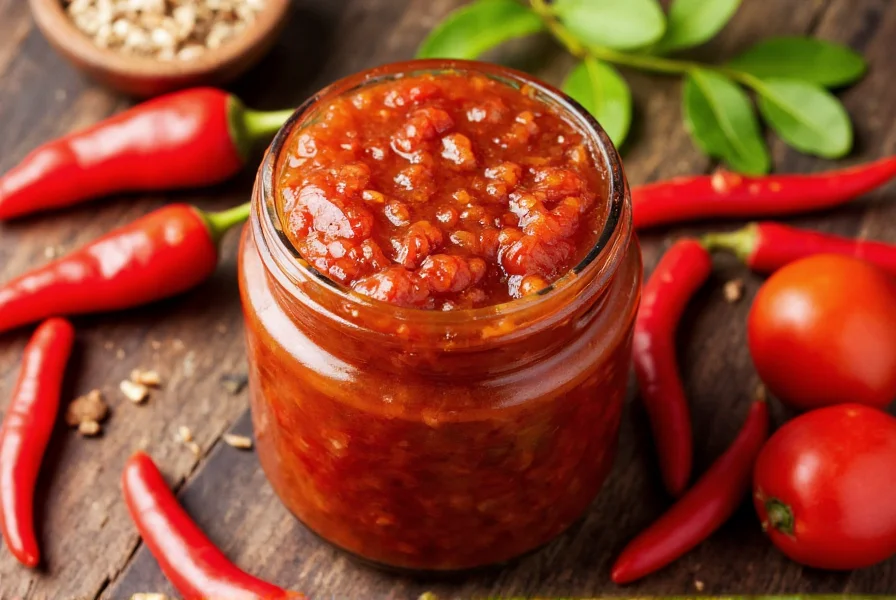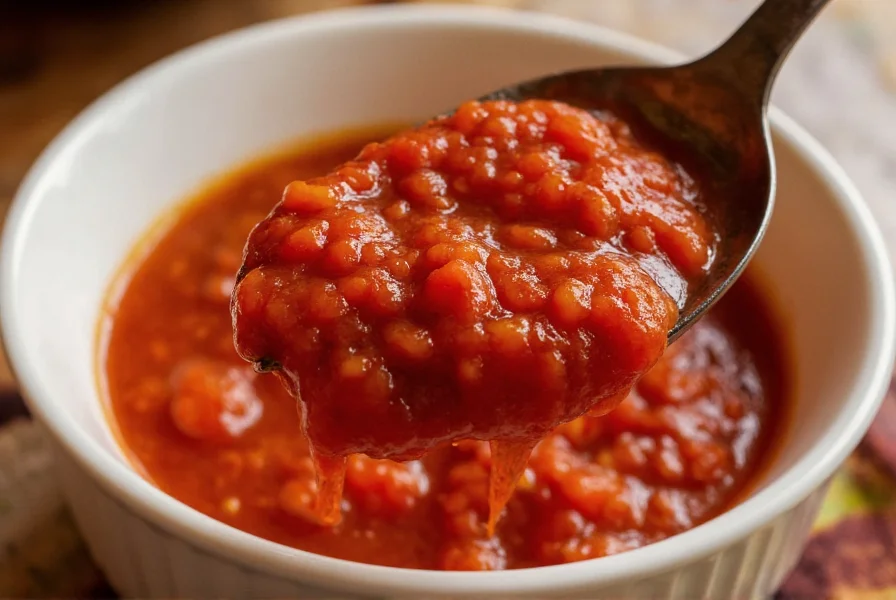Chili jam stands as one of the most versatile condiments in modern kitchens, bridging the gap between heat and sweetness in a way few other ingredients can. This thick, spreadable preparation combines fresh or dried chilies with sugar, vinegar, and often complementary fruits like mango or pineapple to create a complex flavor profile that enhances countless dishes.
What Exactly Is Chili Jam?
Chili jam represents a unique category within spicy condiments, distinguished by its thick texture and balanced flavor profile. While chili sauces tend to be thinner and more liquid, and chili pastes focus primarily on heat with minimal sweetness, chili jam achieves harmony between sweet, sour, and spicy elements.
The base ingredients typically include:
- Fresh or dried chilies (such as red jalapeños, serranos, or Thai bird chilies)
- Substantial sugar content (usually 30-50% of the recipe)
- Vinegar or citrus juice for acidity
- Fruit components like mango, pineapple, or apricot
- Aromatic elements including garlic, ginger, and sometimes spices
Unlike sriracha or chili garlic sauce, which prioritize heat delivery, chili jam's defining characteristic is its spreadable consistency and balanced sweet-spicy profile. The cooking process involves simmering these ingredients until they reach a jam-like thickness, where it holds its shape but remains spreadable.
Chili Jam vs. Similar Condiments
| Condiment Type | Texture | Sweetness Level | Primary Use |
|---|---|---|---|
| Chili Jam | Thick, spreadable | High (30-50% sugar) | Glaze, dip, sandwich spread |
| Chili Sauce | Pourable liquid | Low to moderate | Stir-fries, marinades |
| Chili Paste | Thick paste | Minimal | Flavor base, heat addition |
| Chutney | Variable (chunky to smooth) | Moderate to high | Accompaniment, relish |
This comparison of chili jam versus similar spicy condiments reveals why it occupies a unique space in culinary applications. The substantial sugar content and extended cooking time that characterizes authentic chili jam creates a product that caramelizes beautifully when used as a glaze, something thinner sauces cannot achieve.
Traditional Origins and Modern Adaptations
While chili jam has gained global popularity in recent decades, its roots trace back to Southeast Asian culinary traditions, particularly in Thailand, Malaysia, and Indonesia. Traditional preparations often incorporated local chilies like bird's eye chilies along with palm sugar and tamarind for complexity.
Modern interpretations have expanded significantly, with chefs and home cooks experimenting with:
- Fruit variations (mango chili jam, pineapple chili jam)
- Smoked chili versions using chipotle or smoked paprika
- Low-sugar adaptations for health-conscious consumers
- Fusion styles incorporating ingredients like ginger, lemongrass, or even chocolate
Practical Culinary Applications
Understanding how to use chili jam properly unlocks its full potential in the kitchen. Unlike more aggressive hot sauces, chili jam's balanced profile makes it remarkably versatile across multiple cooking techniques:
As a Glaze
Chili jam's sugar content makes it ideal for creating glossy, flavorful glazes. When applied during the final minutes of cooking, it caramelizes beautifully on proteins. For best results:
- Thin with a small amount of water or broth for easier application
- Apply during the last 5-7 minutes of cooking to prevent burning
- Excellent for grilled chicken wings, salmon fillets, or roasted vegetables
As a Dipping Sauce
Chili jam requires minimal preparation to serve as an exceptional dipping sauce. For restaurant-quality results:
- Mix with equal parts mayonnaise for a creamy chili jam dip
- Combine with soy sauce and rice vinegar for an Asian-inspired dipping sauce
- Pair with spring rolls, dumplings, or roasted potatoes
As a Flavor Base
When incorporated early in cooking, chili jam melts into sauces and marinades, distributing its complex flavors throughout the dish. Professional chefs often:
- Add 1-2 tablespoons to stir-fry sauces
- Use as a base for salad dressings with olive oil and citrus
- Incorporate into barbecue sauces for depth of flavor

Creating Homemade Chili Jam
While quality commercial options exist, making chili jam at home allows for complete customization of heat level and flavor profile. A basic recipe framework includes:
Essential Components
- Chilies: 4-6 fresh red chilies (adjust for heat preference)
- Sweetener: 1 cup sugar (white, brown, or palm sugar)
- Acid: 1/2 cup rice vinegar or lime juice
- Aromatics: 3 garlic cloves, 1-inch ginger, finely minced
- Fruit: 1/2 cup diced mango or pineapple (optional but recommended)
- Thickener: 1 tablespoon cornstarch mixed with 2 tablespoons water
Preparation Method
- Finely chop chilies, removing seeds for milder jam
- Saute aromatics in small oil until fragrant
- Add chilies, sugar, vinegar, and fruit; simmer 15 minutes
- Stir in cornstarch slurry; cook until thickened (5-7 minutes)
- Cool and store in sterilized jars
This basic chili jam recipe can be adapted with additional ingredients like star anise, lemongrass, or even a splash of fish sauce for umami depth. The key to perfect consistency is patience during the simmering process—rushing this step results in a runny product that won't properly coat foods.
Storage Guidelines for Maximum Freshness
Proper storage significantly extends chili jam's shelf life while maintaining flavor quality:
- Refrigerated: Store in airtight container for up to 3 months
- Room temperature: Only safe for commercially processed, sealed jars
- Freezing: Portion into ice cube trays, then transfer to freezer bags for up to 1 year
- Canning: Proper water bath canning extends shelf life to 18 months unopened
Always use clean utensils when serving to prevent contamination. Discard if mold appears, liquid separates significantly, or unpleasant odors develop.

Nutritional Profile and Dietary Considerations
While chili jam delivers exceptional flavor, understanding its nutritional composition helps with mindful usage:
- Calories: Approximately 50-70 per tablespoon (primarily from sugar)
- Sugar content: 10-15g per serving (varies by recipe)
- Heat source: Capsaicin from chilies offers potential metabolic benefits
- Acidity: Vinegar content aids digestion and nutrient absorption
For those monitoring sugar intake, consider these adaptations:
- Reduce sugar by 25-50% and extend cooking time to concentrate natural fruit sugars
- Substitute with monk fruit sweetener for sugar-free version
- Use naturally sweet fruits like ripe mango to reduce added sugar
Perfect Pairings: What Foods Complement Chili Jam Best
Chili jam's versatility shines when paired thoughtfully with complementary foods. These combinations consistently deliver exceptional results:
| Food Category | Recommended Pairings | Application Method |
|---|---|---|
| Proteins | Chicken thighs, pork tenderloin, salmon, shrimp | Glaze during final cooking minutes |
| Vegetables | Roasted sweet potatoes, grilled eggplant, sautéed mushrooms | Stir into finished dish or use as drizzle |
| Carbohydrates | Rice bowls, noodle dishes, sandwiches, wraps | Thin with vinegar for dressing or use as spread |
| Cheeses | Cream cheese, goat cheese, brie | Spread on cheese board or mix into cheese ball |
Professional chefs particularly favor chili jam with fatty proteins, as the sweetness and acidity cut through richness while the heat enhances overall flavor perception. For vegetarian applications, it transforms simple roasted vegetables into standout dishes with minimal effort.
Troubleshooting Common Chili Jam Issues
Even experienced cooks encounter challenges with chili jam preparation. Here's how to address frequent problems:
- Too runny: Return to heat and simmer longer; add additional cornstarch slurry
- Too thick: Stir in small amounts of warm water or vinegar until desired consistency
- Overly sweet: Balance with additional vinegar or citrus juice
- Not spicy enough: Incorporate cayenne pepper or additional minced fresh chilies
- Separation: Reheat gently while whisking to re-emulsify ingredients
Frequently Asked Questions
What's the difference between chili jam and sriracha?
Chili jam has a thick, spreadable consistency with significant sugar content (30-50%), creating a balanced sweet-spicy profile. Sriracha is a thinner, vinegar-based sauce with minimal sugar that emphasizes heat rather than sweetness. Chili jam works well as a glaze or spread, while sriracha functions better as a liquid seasoning.
Can I use chili jam as a substitute for sweet chili sauce?
Yes, chili jam makes an excellent substitute for sweet chili sauce in most applications, though you may need to thin it with vinegar or water for recipes requiring a pourable consistency. The flavor profile is similar, but homemade chili jam typically contains more complex ingredients and less preservatives than commercial sweet chili sauces.
How spicy is typical chili jam?
Most commercial chili jams range from mild to medium heat (2,000-15,000 Scoville units), significantly milder than many hot sauces. The substantial sugar content balances the heat, making it approachable for most palates. Heat level varies by brand and recipe—check ingredient lists for types of chilies used, as this determines spiciness.
What are the best ways to use chili jam in everyday cooking?
The most versatile everyday uses for chili jam include: as a sandwich spread (especially with turkey or chicken), mixed into mayonnaise for dipping sauces, stirred into salad dressings, used as a glaze for roasted proteins, and incorporated into stir-fry sauces. Its balanced flavor profile makes it adaptable to numerous culinary applications beyond traditional Asian dishes.











 浙公网安备
33010002000092号
浙公网安备
33010002000092号 浙B2-20120091-4
浙B2-20120091-4